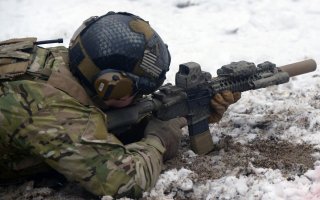The Best of the Best: This is Why Special Forces Are Terrifying to Fight Against
A special review of Elite Warriors: Special Operations Forces From Around the World.
Here's What You Need to Know: “The capability of the SSO will almost certainly continue to improve, and its numerical strength will continue to grow,” Nikolsky wrote. “But a radical improvement that would put the Russian SSO in the same league with the American special operations forces would require the creation of a special helicopter unit, a Russian equivalent of the US Army’s 160th Special Operations Aviation Regiment.”
Edited by Ruslan Pukhov and Christopher Marsh, Elite Warriors: Special Operations Forces From Around the World is an excellent, methodically researched study of various special mission units from around the globe. While information about well-known American and British special operations forces such as the U.S. Army’s elite Delta Force, the U.S. Navy’s SEAL Team Six or the UK’s Special Air Service (SAS) units is fairly commonplace, researchers at Russia’s Centre for Analysis of Strategies and Technologies (CAST) have assembled detailed profiles of foreign units from Russia, Ukraine China and others that cannot be found anywhere else.
“Increasingly scholarly articles are appearing in journals and scholarly presses are beginning to publish more books in the field, with the number of books on related topics growing rapidly every year,” Christopher Marsh writes in his introduction. “What has been lagging, however, has been high-quality comparative research into the global phenomenon of special operations. This is where this volume comes in.”
The book fulfills its mission to fill the “gap by covering the history and current operating environment of the special operations forces of fourteen countries of the world, including many that have tended to get less attention in the English language media, such as Algeria, Italy, and Poland, for example,” as Marsh writes. Indeed, some of the best and most detailed chapters in the book are on foreign special operations forces familiar only to dedicated regional specialists.
Among the best in Elite Warriors are Alexey Ramm and Alexey Nikolsky’s contributions. In their respective chapters, the two researchers detail Moscow’s extensive special operations forces and the Kremlin’s ongoing efforts to revamp those units. Ramm details the post-Soviet reforms of Russia’s elite Spetsnaz troops and their evolving roles and missions. He also provides details about the various units’ training and equipment and their command and control.
Nikolsky’s chapters offer a more historiography approach to the subject—detailing the evolution of Soviet and Russian special operations forces and the politics behind those decisions. “Apart from personal rivalries, interagency squabbling and doctrinal ambiguities, the creation of the SSO was also held back by the lack of funds for any meaningful military reforms,” Nikolsky wrote.
Nikolsky takes the reader from the Soviet-era focus on nuclear war, through Afghanistan and the Russian experiences in the Caucuses and Ukraine through to today’s conflict in Syria. Western readers are sure to find the story of the creation of Russia’s Special Operations Command (SSO)—patterned on the American Joint Special Operations Command—to be fascinating, particularly as the unit continues to evolve.
“The capability of the SSO will almost certainly continue to improve, and its numerical strength will continue to grow,” Nikolsky wrote. “But a radical improvement that would put the Russian SSO in the same league with the American special operations forces would require the creation of a special helicopter unit, a Russian equivalent of the US Army’s 160th Special Operations Aviation Regiment.”
Other highlights include Yuri Liamin’s chapter on Iran’s special operations forces and the Quds Force, which U.S. forces often encounter but few in Washington know much about. “It is in fact a specialized intelligence service, trained and equipped for exerting covert influence and carrying out sensitive foreign-policy missions,” Liamin wrote. “It is, however, quite distinct from the regular IRGC military intelligence, which is a purely intelligence-gathering service.”
Also illuminating is Vasily Kashin’s very detailed examination of the Chinese People’s Liberation Army’s special operations forces, which included much information that is not widely known. “The People’s Republic of China began to build up the special operations component of its armed forces much later than most of the world’s leading military powers,” Kashin writes. “Beijing’s decision to develop a special operations capability was prompted by a protracted border conflict with Vietnam, which lasted throughout most of the 1980s. The SOF program was further prioritized after the Chinese analyzed the lessons of the first Gulf war in 1990-1991.”
Overall, Elite Warriors: Special Operations Forces From Around the World is an exceptionally well-researched booked and forms a valuable resource for scholars studying special operations forces—particularly those that are not of American or British origin. Each one of the chapters—which are essentially stand alone research papers—offer detailed analyses of various nations’ forces—often with details not found anywhere else. Scholars in Washington will find the sections on Russia, Ukraine, Iran and China to be particularly useful.
This piece first appeared in 2018 and is being reprinted due to reader interest.

